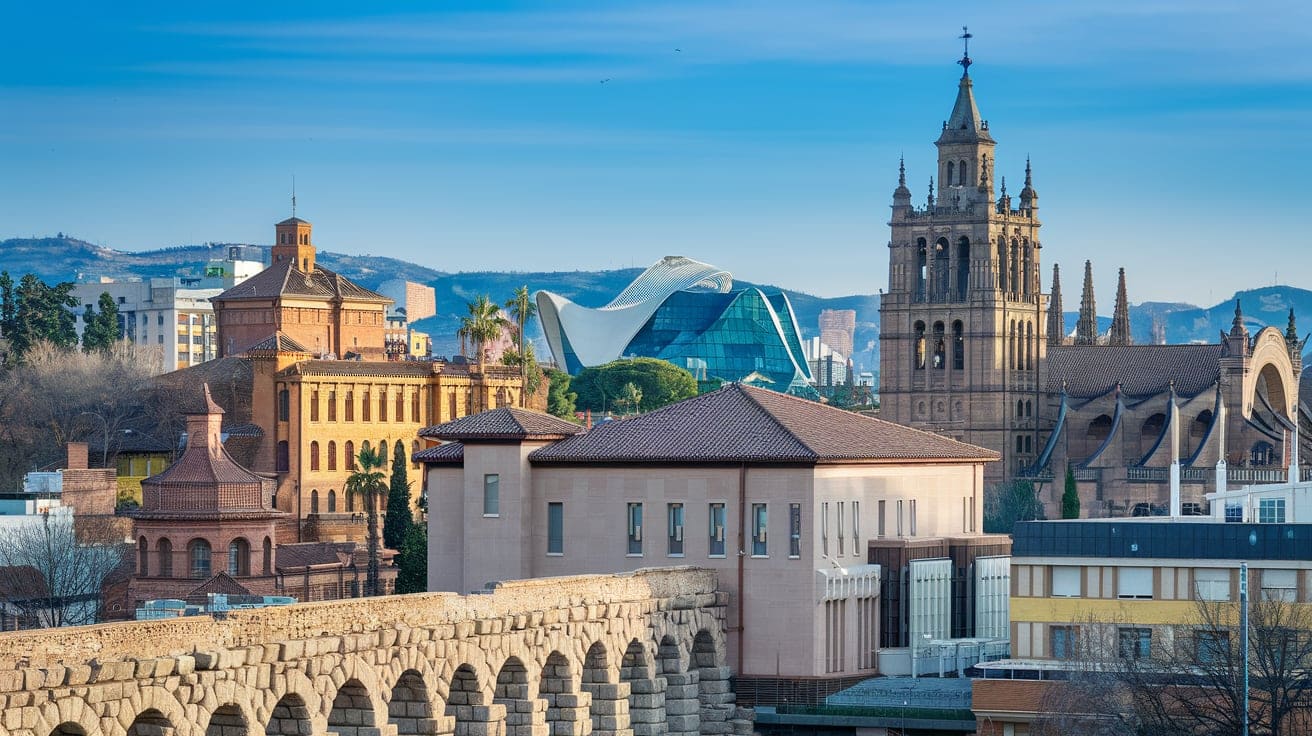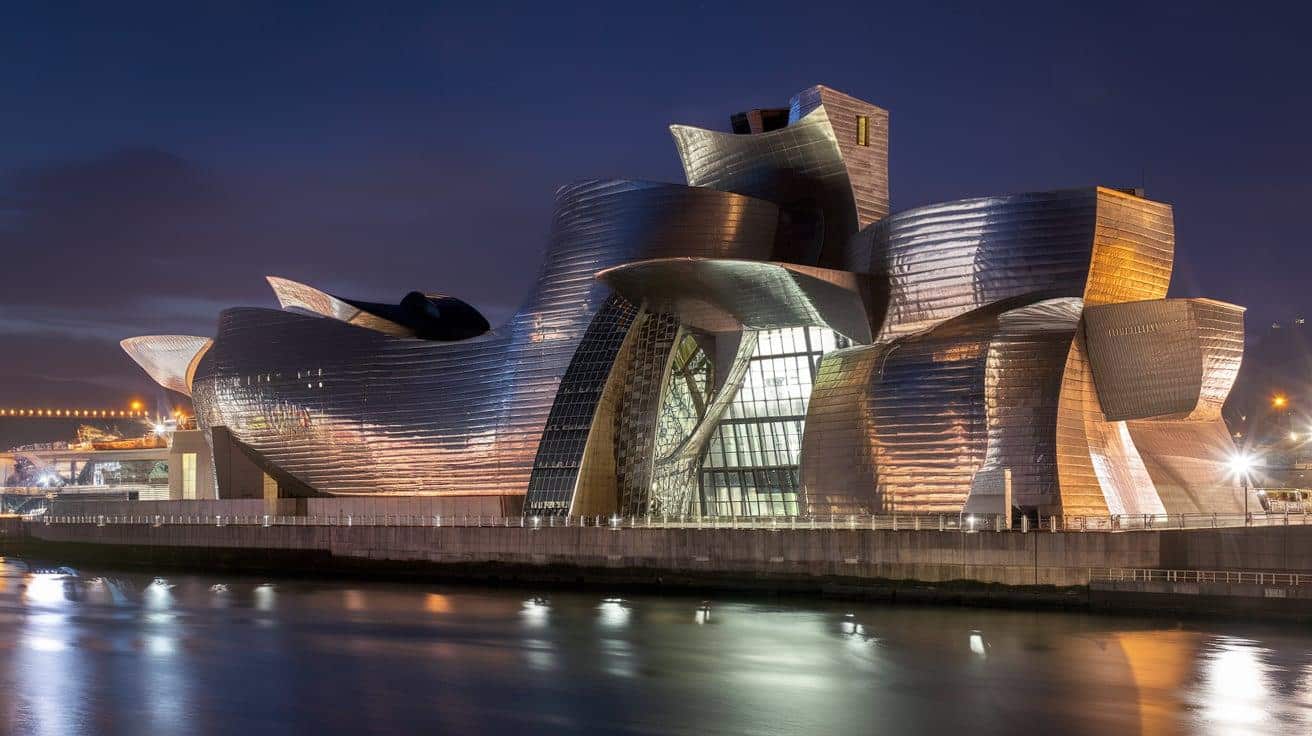Architecture in Spain is truly amazing, mixing old and new styles from different cultures. I fell in love with everything from Gaudí’s quirky buildings to Valencia’s futuristic City of Arts and Sciences.
But let’s be honest, trying to see it all can be really confusing and overwhelming.
I’ve traveled around Spain for years, checking out these beautiful buildings, and I want to make it easier for you. In this blog, I’ll show you exactly where to go, how to get there, and why these places matter.
I’ll cover everything from ancient history to today’s cutting-edge designs, local styles in different regions, and those must-see landmarks that make Spain special.
Trust me, this guide will make your architectural adventure so much smoother.
The Historical Roots of Spanish Architecture
Spain’s buildings tell amazing stories from the past. The Romans came first, building sturdy roads, bridges, and aqueducts that still stand today, like the incredible aqueduct in Segovia, which is almost 2,000 years old!
Then came the Moors, who brought beautiful Islamic designs. They created stunning places like the Alhambra in Granada with intricate patterns, peaceful courtyards, and amazing arches that make you stop and stare.
When Christianity spread, massive Gothic cathedrals reached toward the sky in cities like Barcelona and Toledo. The earlier Romanesque churches, with their thick walls and round arches, can still be found in small villages across northern Spain.
What I love most is how these styles didn’t just replace each other; they blended.
The Legacy of Antoni Gaudí and Modernisme
You can’t talk about Spanish architecture without mentioning Antoni Gaudí, the wild genius who changed Barcelona forever! His buildings look like they’re from a fairy tale or another planet.
The Sagrada Família is his masterpiece, a massive church that’s still being built after more than 100 years! Inside, it feels like you’re standing in a colorful forest with light pouring through stained glass windows. It’s nothing like any church you’ve ever seen.
At Casa Batlló, Gaudí created a building that looks alive with wavy walls, a roof like a dragon’s back, and not a straight line in sight. Park Güell is basically a magical playground with mosaic benches and strange stone columns.
Gaudí was part of a bigger movement called Catalan Modernisme, where artists in Barcelona broke all the rules. They used curves instead of straight lines, added lots of nature-inspired details, and weren’t afraid of bright colors and weird shapes.
What’s amazing is how Gaudí’s crazy ideas influenced architects all over the world. Even today, when designers want to create something organic and unexpected, they look to Gaudí for inspiration. His buildings show that architecture doesn’t have to be boring boxes; it can be playful, surprising, and full of imagination.
Regional Styles and Local Identity
To better understand how architecture varies across Spain, here’s a quick comparison of key features, materials, and iconic examples from five culturally distinct regions.
| Region | Key Features | Common Materials | Iconic Example |
|---|---|---|---|
| Andalusia | Courtyards, arches, tilework | Stucco, ceramic tile | Alhambra, Córdoba patios |
| Basque Country | Farmhouses, minimalist modern | Stone, wood, glass | Baserri, San Sebastián Kursaal |
| Catalonia | Modernisme, Gothic, vibrant colors | Iron, mosaic, stone | Sagrada Família, Casa Batlló |
| Castile | Stone-heavy medieval, fortress-like | Limestone, granite | Ávila Walls, Segovia Alcázar |
| Galicia | Sloped roofs, granite buildings | Granite, slate | Santiago de Compostela Cathedral |
Contemporary Spanish Architecture and Innovation
Spanish architecture today? It’s on fire! Architects here aren’t just building structures; they’re making statements that capture attention worldwide.
Take Santiago Calatrava. This guy creates buildings that look like they might fly away! His City of Arts and Sciences in Valencia resembles giant skeletons or spacecraft that landed in the middle of town.
What makes Spanish innovation special
- They’re masters at contrast, placing ultra-modern buildings right next to ancient ones.
- They’re not afraid of bold shapes that challenge what’s possible
- Spanish architects love playing with light
- They often incorporate water features that create stunning reflections
- Many projects become instant landmarks that transform entire neighborhoods
Green thinking is taking off in Spain in a big way. Barcelona has these “superblocks” that keep cars out and let people enjoy the streets. In Seville, they built this huge wooden structure locals call “The Mushrooms” that gives shade when it’s hot and even makes solar power.
Madrid turned an old, ugly highway into a beautiful park along the river. These projects don’t just look good – they make life better for everyone.
What I really love is how Spanish architects mix new materials with old settings. They’ll take modern glass and steel but use them in ways that respect tradition. At the Caixa Forum in Madrid, they did something crazy: they picked up an old brick building and put a rusty metal piece on top! In León, the MUSAC museum has colorful glass windows that remind you of the old cathedral nearby.
These buildings have personalities. They’re not boring office towers. There’s always something fun or surprising that connects to Spanish culture and makes you smile.
Iconic Landmarks You Must See
1. Palaces, Museums, and Mind-Blowing Buildings
Spain is packed with buildings that’ll make your jaw drop! These aren’t just pretty places to take selfies; they tell Spain’s story and show what makes this country special.
2. The Alhambra: A Palace from A Fairy Tale
Sitting on a hill in Granada is the Alhambra a palace so beautiful it seems unreal. The Moorish kings built it with incredibly detailed carvings, peaceful gardens, and fountains everywhere.
Walking through its rooms feels like stepping into another world. What I love most are the tiny details. Look up, and you’ll see patterns that seem to go on forever.
3. The Guggenheim Bilbao: Shiny, Curvy, and Game-Changing
This shiny titanium museum looks like a spaceship landed in northern Spain! Designed by Frank Gehry, it completely transformed Bilbao from an industrial city to a tourist hotspot. Inside and out, the building seems to change shape as you walk around it.
The coolest part? It successfully put Bilbao on the map, and people now talk about the “Guggenheim Effect,” when architecture revives a city.
4. The City of Arts and Sciences: Valencia’s Futuristic Wonderland
This group of buildings looks like it’s from a sci-fi movie. With a giant eye-shaped opera house, a science museum that resembles a whale skeleton, and pools of bright blue water, it’s become the symbol of modern Valencia.
Wrapping Up
From Roman aqueducts to Gaudí’s fantastical creations, Spain’s architecture tells the story of a nation constantly reinventing itself while honoring its past.
What makes Spanish architecture truly special is how seamlessly old and new coexist, creating a visual conversation across centuries.
So why does this matter? Understanding Spain’s buildings gives you deeper insight into its culture, history, and innovative spirit. These aren’t just beautiful structures; they’re expressions of Spanish identity.
Whether you’re drawn to the intricate Islamic patterns of the Alhambra, the mind-bending curves of Modernisme, or the bold statements of contemporary Spanish architects, there’s something here to inspire you.
Each building offers a unique window into the Spanish soul.













